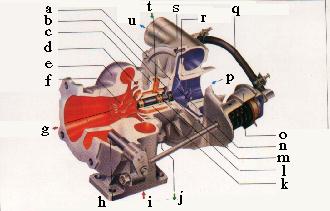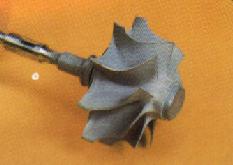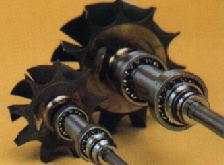
![]()

![]()
Briefly, an engine is turboboosted when it contains a turbo that uses exhaust gas pressure to supply air under pressure to the inlet manifold.
A turbo is a housing that contains an axis which joins two turbines. One of them is moved by the exhaust gas and the other one is used to compress the inlet air. The axis rotates at very high speeds, so it requires a continuous oiling.
 |
Legend: a-Inlet turbine housing, b-Bearing, c-Central housing, d-Heat shield, e-Exhaust turbine housing, f-Turbine and axis, g-Exhaust gas output, h-Wastegate, i-Exhaust gas input, j-Oil output, k-Friction bearing location, l-Friction bearing, m-Graphite joint, n-Compressor, o-Bypass actuator, p-Inlet air input, q-Actuator hose, r-Diffusor, s-Inlet turbine housing, t-Oil input, u-Inlet air output |
 |
 |
This drives to a better energy use, as the exhaust flow pressure depends mainly on the engine revolution level, and the cynetic energy it contains would lose unless it's changed into mechanical energy by the exhaust turbine, if we have a turbo. With the inlet turbine actuation, investing this energy to compress the inlet air, we improve the cylinder filling, so improving combustion.
There are three basic issues related to turbocompressed engines:
To achieve this, the 'wastegate' valve is used. It works bypassing the exhaust turbine so that not all the exhaust flow reaches it, applying that way the necessary negative feedback keep the system stable.
The wastegate is initially closed. All the exhaust gas reaches the exhaust turbine, but, having its shovels more or less straight shape, and finding an easy way out through the exhaust pipe, the turbo stands still and there is no boost pressure. When the engine revs, the turbo starts moving. There is too much exhaust flow to get out of the turbine in order, and gases create a pressure that makes the turbine spin. The turbo is starting to work.
Regulation is achieved using the wastegate, so when there is a certain inlet manifold turbo boost pressure, it starts opening, letting some exhaust gas bypass the turbine, and so don't letting the turbo boost pressure grow. At 1.0 bar (14 psi) the wastegate should be completely open (although it never reaches that pressure because of the partial wastegate valve opening) , but if everything fails, at 1.1 bar (16 psi)we have a safety switch in the intercooler hose that cuts the ignition...
The adjustment of the opening point of the wastegate is done in a mechanical way, modifying the length of the wastegate actuator and so setting the boost pressure. This is why some standard GTT turbo manometers show slightly more pressure than others, because this setting has some tolerance.
Idling for a while after engine start and before engine stop
The low tolerances of turbo bearings are designed to allow it to spin at their high speed when the axle/bearings are at their working temperatures. When the engine is started, it takes some time for the oil to lubricate properly the turbo. And in addition, the high temperatures that the turbo housing can cope with shouldn't be reached suddenly (risk of thermical shock and cracking).
That's the reason to let the engine warm before using the turbo. I don't use the turbo at all until the temperature gauge shows 60°C (1/3 of de dial line) and then I try to make it work gradually, not just stepping the gas pedal...
When you're going to stop the car, specially if you've been using the turbo hard up to then (you are in the motorway and stop to fill the tank, for example), the turbo is at very high temperature. You even can see images of red turbo housings at test benches! If you'd stop the engine and let it cool, the oil that's contained into the turbo would burn, creating solid deposits in the bearings that would shorten their life. And of course if the engine is stopped suddenly, the turbo could even be still spinning, and as you cut the oil flow abruptly, the bearings would really suffer...
That's why you should let the engine idle for a while before switching off the engine. The Renault 21 Turbo had an electrical water pump that worked when you switched off the engine to cool the turbo and avoid this effect.
Have you heard something like this?
'5 Turbos have a problem: If you gear down, turbo enters and, instead of reducing the speed of the car, it accelerates. This is why many people have killed themselves with these cars.'
If you take your foot out of the gas pedal, you close the carburettor throttle, and leave the engine without much fuel to burn, just the idling quantity plus a little the engine can suck itself (That's why it revs down :-) ). Exhaust pressure is created by the air the engine breaths, that depends on the engine speed and its size, but it's mainly due to the increased volume of the gases made from fuel combustion using that air. With little fuel, little exhaust gas pressure, so turbo doesn't work. That's why when you gear down, revving the engine as much as you want, the boost gauge doesn't rise.
But every legend has a little bit of truth, because there are two ways to mount a turbocharger. The GTT uses a 'blowed' carburettor (Air -> turbo -> carb -> engine) and then the carburettor throttle is just over the engine, so it can cut the air/fuel supply abruptly. But the old R5 Alpine turbo had a 'sucked' one (Air -> carb -> turbo -> engine). That way there is an amount of air/fuel mixture located between the carburettor throttle and the engine, and the deceleration effect isn't that fast...
In addition to this, the GTT turbo system is not as easy as a single hose that takes boost inlet pressure and makes the wastegate open when necessary (Apart from the coupe modification). We have a lot of hoses there in the engine bay, and they make turbo actuation softer.
The nicknames for the GT Turbo (The open tomb, the coffin...) come from the fact that with only 1397cc to reduce when you step out of the gas pedal, the car makes an impressive 120bhp to accelerate, and the human brain is weak...
Increasing the boost pressure and bleed valves
Increasing the boost pressure (the standard is 0.68 bar, 9.8 psi) is an effective way to increase the engine power. The problems with this are:
To increase the boost pressure, the first solution is to modify the wastegate actuator length. This is a cheap, simple and clean method, but it has a drawback: you can't modify it on-the-fly.
Another way is to install a bleed valve. It will create a controlled air leaks at the turbo actuator hose and then makes more boost pressure necessary to open the wastegate. The advantage is that you can set up the leak (and so the boost pressure) with the valve, what allows you to choose between different boost pressures, according to your needs.
And the better solution, an electronic boost controller, a kind of automatic bleed valve to control the turbo system.
When you get the foot out of the gas pedal, the exhaust gas pressure disappears, but this is not the reason why you lose all boost pressure when you change gears, because the turbine is spinning at very high speeds (up to 120.000 r.p.m.) and it shouldn't stop easily. The problem is that you close the carburettor throttle, where the boost pressure goes, making the turbine stop abruptly.
This violent closure gives you that dead time without boost pressure while changing gears and, with high boost pressures, it even can damage the carb or the turbo itself.
To avoid this, there are dump valves. They work by opening an alternate way out to boost pressure when it's needed, releasing the system gradually and safely from the boost pressure and so letting the turbine drop speed as slow as possible.